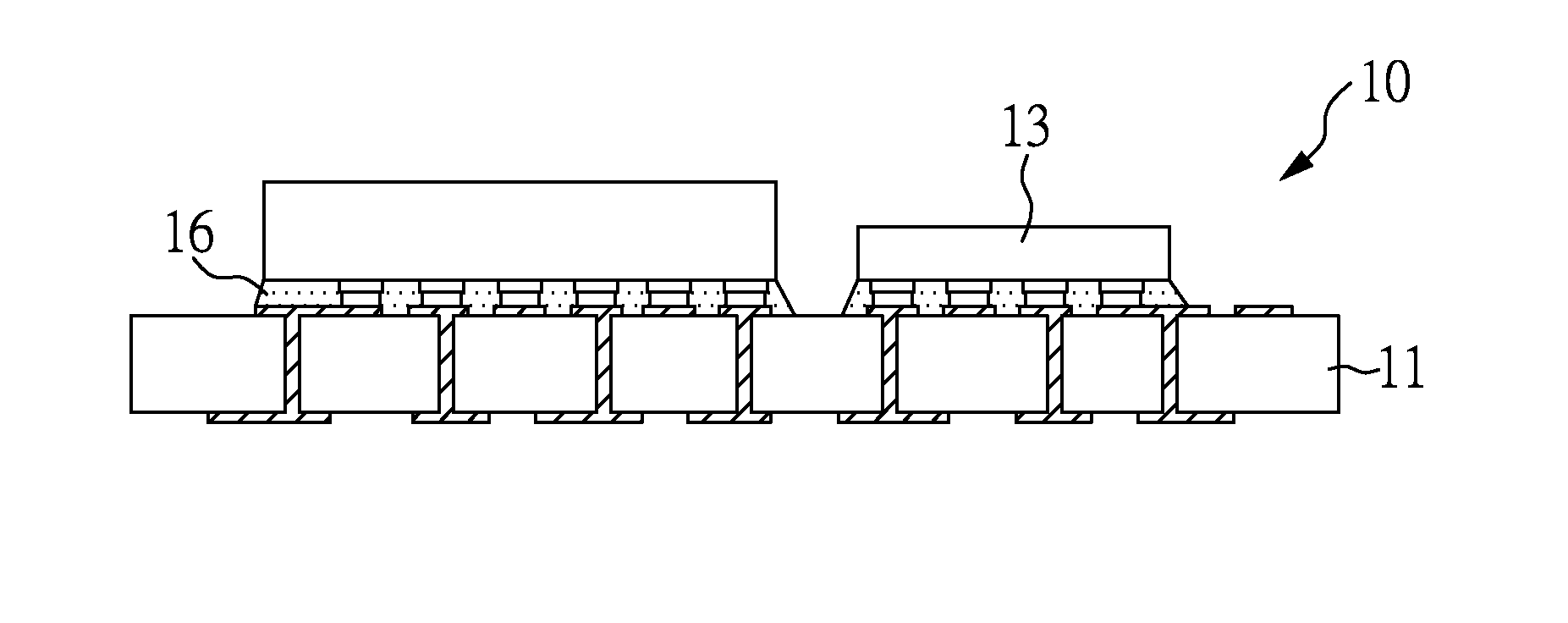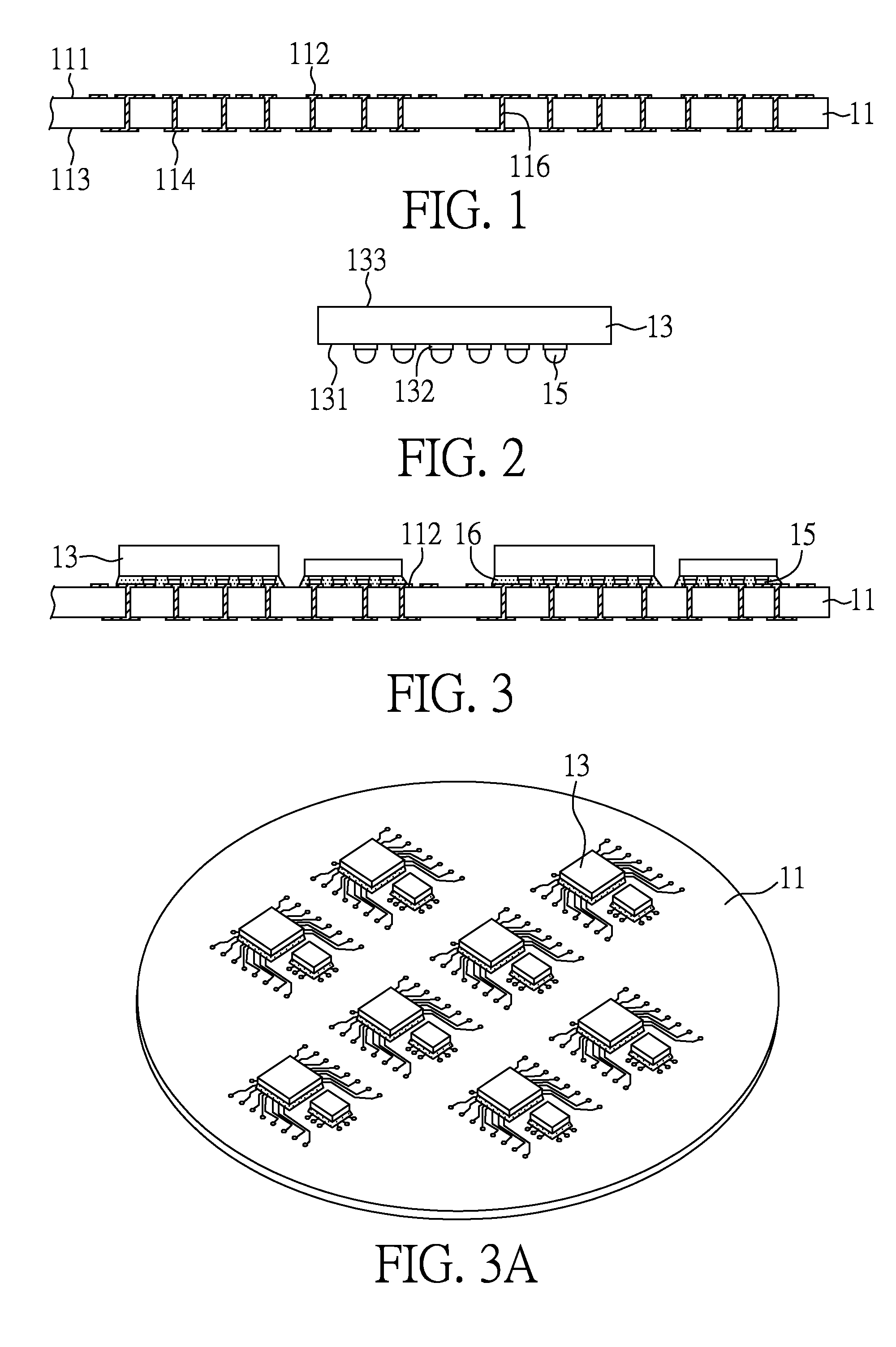Thermally enhanced semiconductor assembly with embedded chip and interposer and method of manufacturing the same
- Summary
- Abstract
- Description
- Claims
- Application Information
AI Technical Summary
Benefits of technology
Problems solved by technology
Method used
Image
Examples
embodiment 1
[0045]FIGS. 1-14 are cross-sectional views showing a method of making a thermally enhanced semiconductor assembly that includes an interposer, chips, a heat sink and build-up circuitry in accordance with an embodiment of the present invention.
[0046]As shown in FIG. 14, semiconductor assembly 110 includes interposer 11, chips 13, heat sink 20 and build-up circuitry 30. Interposer 11 and chips 13 are attached on heat sink 20 using adhesive 19 with chips 13 embedded in cavities 211 of heat sink 20 and alignment guide 213 laterally aligned with peripheral edges of interposer 11. Alignment guide 213 extends beyond first surface 111 of interposer 11 in the upward direction and is in close proximity to peripheral edges of interposer 11. Build-up circuitry 30 covers interposer 11 and heat sink 20 in the upward direction and is electrically coupled to second contact pads 114 of interposer 11 through first conductive vias 317.
[0047]FIGS. 1-5 are cross-sectional views showing a process of fabr...
embodiment 2
[0068]FIGS. 15-19 are cross-sectional views showing a method of making another thermally enhanced semiconductor assembly with additional conductive vias in contact with the heat sink in accordance with another embodiment of the present invention.
[0069]For purposes of brevity, any description in above Embodiment is incorporated herein insofar as the same is applicable, and the same description need not be repeated.
[0070]FIGS. 15 and 15A are cross-sectional and top perspective views, respectively, of heat sink 20 with alignment guide 213 around entrance of cavity 211. Alignment guide 213 can be formed by removing selected portions of metallic base sheet 21 or by pattern deposition including electroplating, electroless plating, evaporating, sputtering and their combinations using photolithographic process. In this illustration, as shown in FIG. 15A, alignment guide 213 laterally extends to the peripheral edges of heat sink 20 and has inner peripheral edges that conforms to four sides o...
embodiment 3
[0076]FIGS. 20-26 are cross-sectional views showing a method of making yet another thermally enhanced semiconductor assembly with an laminate substrate as the heat sink in accordance with yet another embodiment of the present invention.
[0077]For purposes of brevity, any description in above Embodiments is incorporated herein insofar as the same is applicable, and the same description need not be repeated.
[0078]FIGS. 20 and 21 are cross-sectional views showing a process of forming an alignment guide on a dielectric layer of a laminated substrate in accordance with an embodiment of the present invention, and FIG. 21A is a top perspective view corresponding to FIG. 21.
[0079]FIG. 20 is a cross-sectional view of a laminate substrate that includes metallic base sheet 21, dielectric layer 23 and metal layer 25. Dielectric layer 23 is sandwiched between metallic base sheet 21 and metal layer 25. Dielectric layer 23 typically is made of epoxy resin, glass-epoxy, polyimide and the like and ha...
PUM
 Login to View More
Login to View More Abstract
Description
Claims
Application Information
 Login to View More
Login to View More - R&D
- Intellectual Property
- Life Sciences
- Materials
- Tech Scout
- Unparalleled Data Quality
- Higher Quality Content
- 60% Fewer Hallucinations
Browse by: Latest US Patents, China's latest patents, Technical Efficacy Thesaurus, Application Domain, Technology Topic, Popular Technical Reports.
© 2025 PatSnap. All rights reserved.Legal|Privacy policy|Modern Slavery Act Transparency Statement|Sitemap|About US| Contact US: help@patsnap.com



